Using Criticism - English and Related Literature
VerifiedAdded on 2022/08/15
|6
|1438
|12
AI Summary
Criticism Essay
Contribute Materials
Your contribution can guide someone’s learning journey. Share your
documents today.
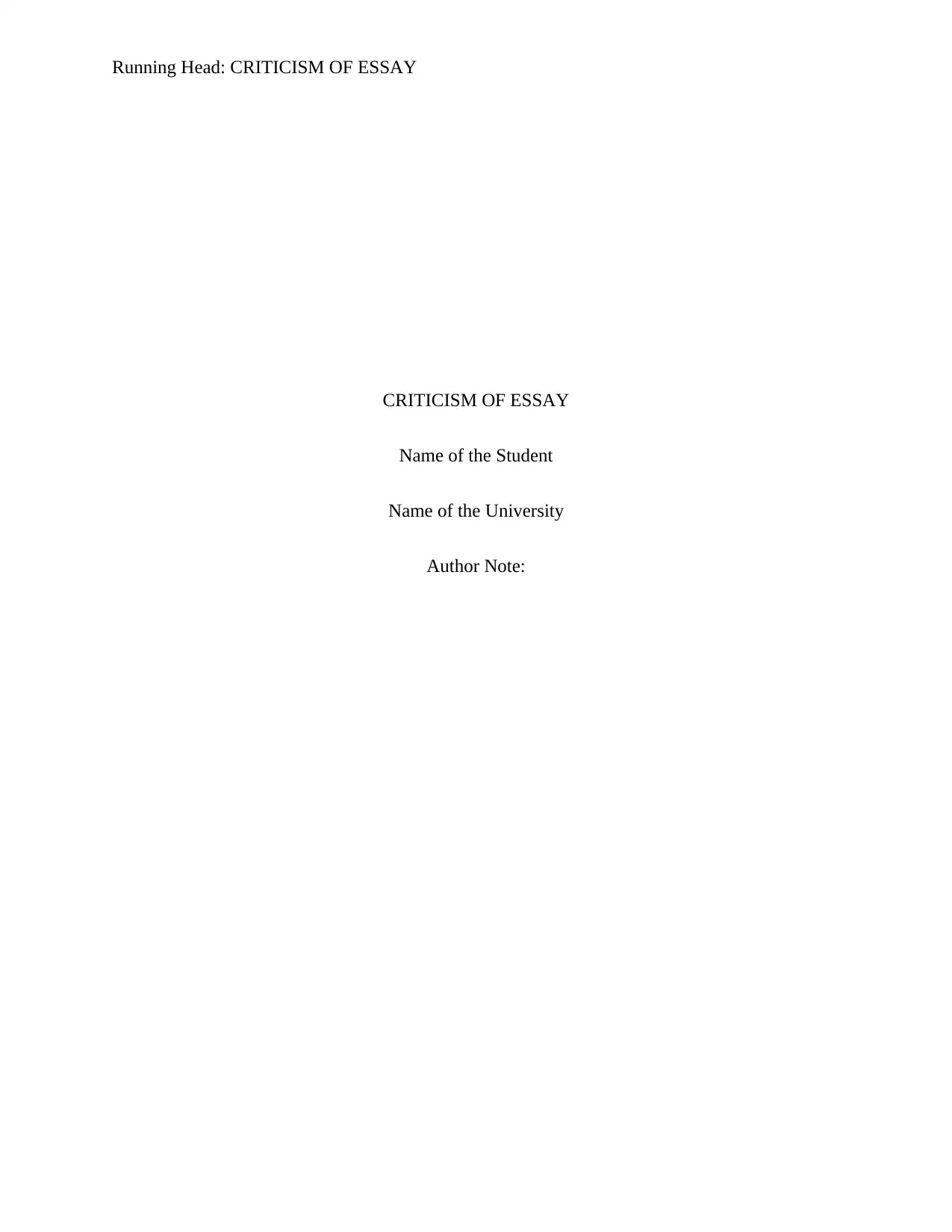
Running Head: CRITICISM OF ESSAY
CRITICISM OF ESSAY
Name of the Student
Name of the University
Author Note:
CRITICISM OF ESSAY
Name of the Student
Name of the University
Author Note:
Secure Best Marks with AI Grader
Need help grading? Try our AI Grader for instant feedback on your assignments.
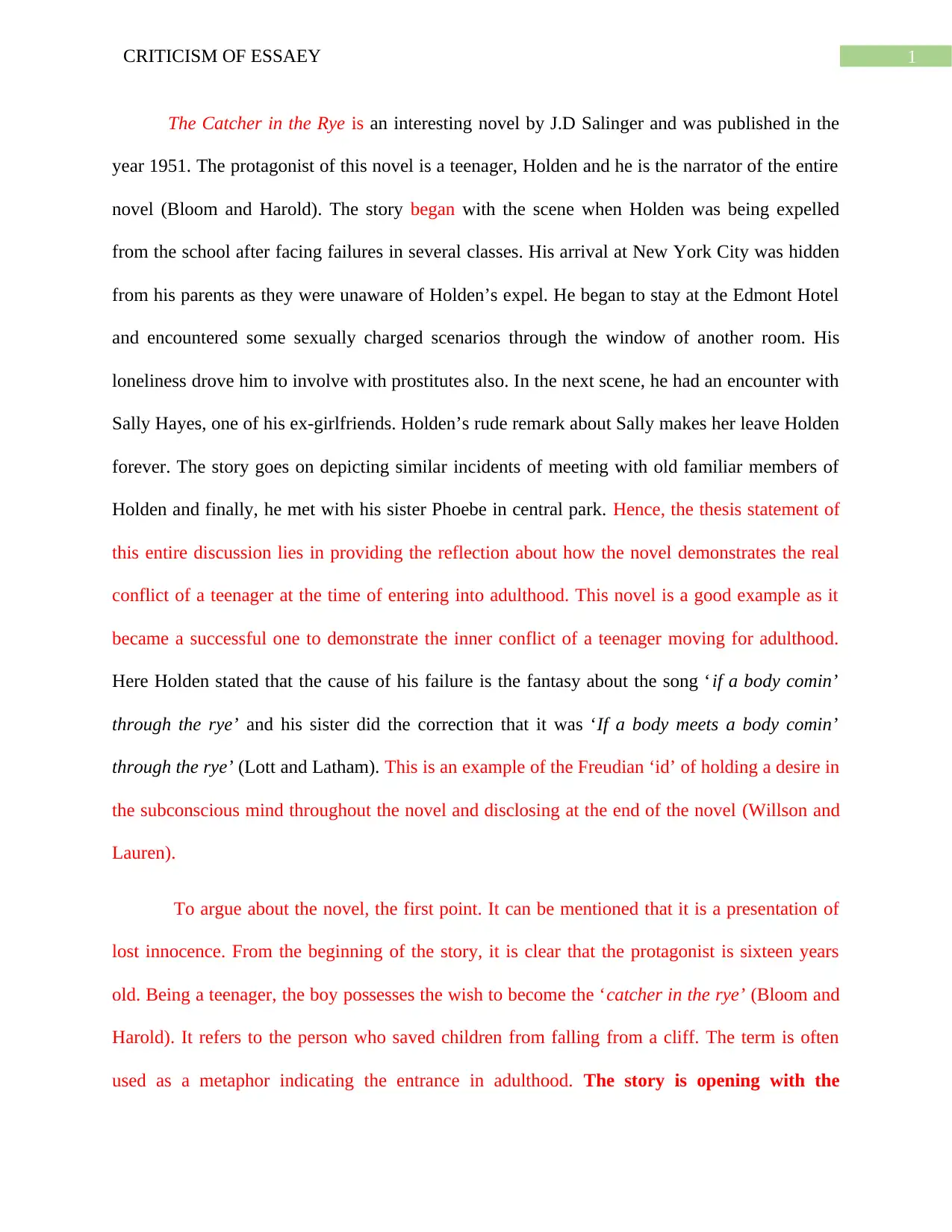
1CRITICISM OF ESSAEY
The Catcher in the Rye is an interesting novel by J.D Salinger and was published in the
year 1951. The protagonist of this novel is a teenager, Holden and he is the narrator of the entire
novel (Bloom and Harold). The story began with the scene when Holden was being expelled
from the school after facing failures in several classes. His arrival at New York City was hidden
from his parents as they were unaware of Holden’s expel. He began to stay at the Edmont Hotel
and encountered some sexually charged scenarios through the window of another room. His
loneliness drove him to involve with prostitutes also. In the next scene, he had an encounter with
Sally Hayes, one of his ex-girlfriends. Holden’s rude remark about Sally makes her leave Holden
forever. The story goes on depicting similar incidents of meeting with old familiar members of
Holden and finally, he met with his sister Phoebe in central park. Hence, the thesis statement of
this entire discussion lies in providing the reflection about how the novel demonstrates the real
conflict of a teenager at the time of entering into adulthood. This novel is a good example as it
became a successful one to demonstrate the inner conflict of a teenager moving for adulthood.
Here Holden stated that the cause of his failure is the fantasy about the song ‘if a body comin’
through the rye’ and his sister did the correction that it was ‘If a body meets a body comin’
through the rye’ (Lott and Latham). This is an example of the Freudian ‘id’ of holding a desire in
the subconscious mind throughout the novel and disclosing at the end of the novel (Willson and
Lauren).
To argue about the novel, the first point. It can be mentioned that it is a presentation of
lost innocence. From the beginning of the story, it is clear that the protagonist is sixteen years
old. Being a teenager, the boy possesses the wish to become the ‘catcher in the rye’ (Bloom and
Harold). It refers to the person who saved children from falling from a cliff. The term is often
used as a metaphor indicating the entrance in adulthood. The story is opening with the
The Catcher in the Rye is an interesting novel by J.D Salinger and was published in the
year 1951. The protagonist of this novel is a teenager, Holden and he is the narrator of the entire
novel (Bloom and Harold). The story began with the scene when Holden was being expelled
from the school after facing failures in several classes. His arrival at New York City was hidden
from his parents as they were unaware of Holden’s expel. He began to stay at the Edmont Hotel
and encountered some sexually charged scenarios through the window of another room. His
loneliness drove him to involve with prostitutes also. In the next scene, he had an encounter with
Sally Hayes, one of his ex-girlfriends. Holden’s rude remark about Sally makes her leave Holden
forever. The story goes on depicting similar incidents of meeting with old familiar members of
Holden and finally, he met with his sister Phoebe in central park. Hence, the thesis statement of
this entire discussion lies in providing the reflection about how the novel demonstrates the real
conflict of a teenager at the time of entering into adulthood. This novel is a good example as it
became a successful one to demonstrate the inner conflict of a teenager moving for adulthood.
Here Holden stated that the cause of his failure is the fantasy about the song ‘if a body comin’
through the rye’ and his sister did the correction that it was ‘If a body meets a body comin’
through the rye’ (Lott and Latham). This is an example of the Freudian ‘id’ of holding a desire in
the subconscious mind throughout the novel and disclosing at the end of the novel (Willson and
Lauren).
To argue about the novel, the first point. It can be mentioned that it is a presentation of
lost innocence. From the beginning of the story, it is clear that the protagonist is sixteen years
old. Being a teenager, the boy possesses the wish to become the ‘catcher in the rye’ (Bloom and
Harold). It refers to the person who saved children from falling from a cliff. The term is often
used as a metaphor indicating the entrance in adulthood. The story is opening with the
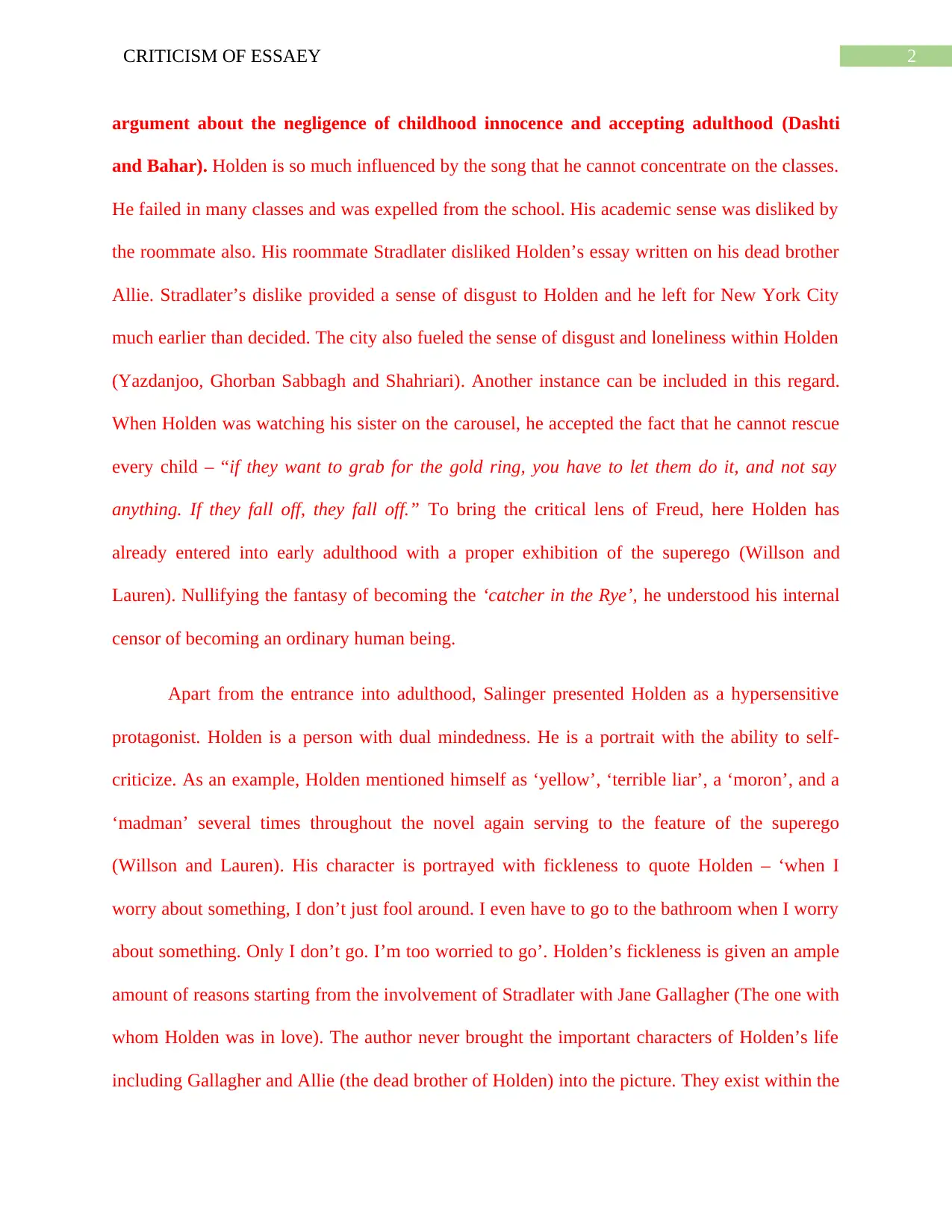
2CRITICISM OF ESSAEY
argument about the negligence of childhood innocence and accepting adulthood (Dashti
and Bahar). Holden is so much influenced by the song that he cannot concentrate on the classes.
He failed in many classes and was expelled from the school. His academic sense was disliked by
the roommate also. His roommate Stradlater disliked Holden’s essay written on his dead brother
Allie. Stradlater’s dislike provided a sense of disgust to Holden and he left for New York City
much earlier than decided. The city also fueled the sense of disgust and loneliness within Holden
(Yazdanjoo, Ghorban Sabbagh and Shahriari). Another instance can be included in this regard.
When Holden was watching his sister on the carousel, he accepted the fact that he cannot rescue
every child – “if they want to grab for the gold ring, you have to let them do it, and not say
anything. If they fall off, they fall off.” To bring the critical lens of Freud, here Holden has
already entered into early adulthood with a proper exhibition of the superego (Willson and
Lauren). Nullifying the fantasy of becoming the ‘catcher in the Rye’, he understood his internal
censor of becoming an ordinary human being.
Apart from the entrance into adulthood, Salinger presented Holden as a hypersensitive
protagonist. Holden is a person with dual mindedness. He is a portrait with the ability to self-
criticize. As an example, Holden mentioned himself as ‘yellow’, ‘terrible liar’, a ‘moron’, and a
‘madman’ several times throughout the novel again serving to the feature of the superego
(Willson and Lauren). His character is portrayed with fickleness to quote Holden – ‘when I
worry about something, I don’t just fool around. I even have to go to the bathroom when I worry
about something. Only I don’t go. I’m too worried to go’. Holden’s fickleness is given an ample
amount of reasons starting from the involvement of Stradlater with Jane Gallagher (The one with
whom Holden was in love). The author never brought the important characters of Holden’s life
including Gallagher and Allie (the dead brother of Holden) into the picture. They exist within the
argument about the negligence of childhood innocence and accepting adulthood (Dashti
and Bahar). Holden is so much influenced by the song that he cannot concentrate on the classes.
He failed in many classes and was expelled from the school. His academic sense was disliked by
the roommate also. His roommate Stradlater disliked Holden’s essay written on his dead brother
Allie. Stradlater’s dislike provided a sense of disgust to Holden and he left for New York City
much earlier than decided. The city also fueled the sense of disgust and loneliness within Holden
(Yazdanjoo, Ghorban Sabbagh and Shahriari). Another instance can be included in this regard.
When Holden was watching his sister on the carousel, he accepted the fact that he cannot rescue
every child – “if they want to grab for the gold ring, you have to let them do it, and not say
anything. If they fall off, they fall off.” To bring the critical lens of Freud, here Holden has
already entered into early adulthood with a proper exhibition of the superego (Willson and
Lauren). Nullifying the fantasy of becoming the ‘catcher in the Rye’, he understood his internal
censor of becoming an ordinary human being.
Apart from the entrance into adulthood, Salinger presented Holden as a hypersensitive
protagonist. Holden is a person with dual mindedness. He is a portrait with the ability to self-
criticize. As an example, Holden mentioned himself as ‘yellow’, ‘terrible liar’, a ‘moron’, and a
‘madman’ several times throughout the novel again serving to the feature of the superego
(Willson and Lauren). His character is portrayed with fickleness to quote Holden – ‘when I
worry about something, I don’t just fool around. I even have to go to the bathroom when I worry
about something. Only I don’t go. I’m too worried to go’. Holden’s fickleness is given an ample
amount of reasons starting from the involvement of Stradlater with Jane Gallagher (The one with
whom Holden was in love). The author never brought the important characters of Holden’s life
including Gallagher and Allie (the dead brother of Holden) into the picture. They exist within the
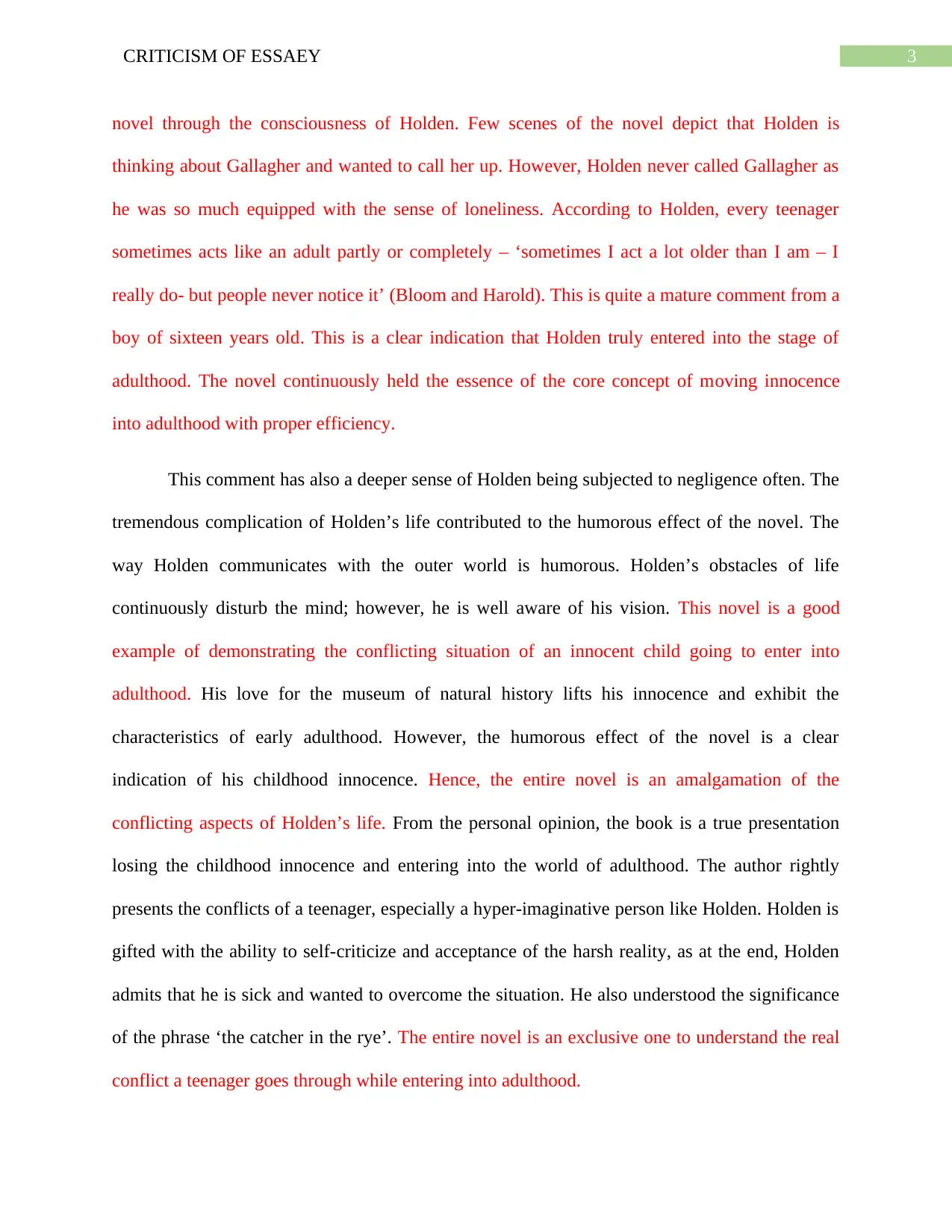
3CRITICISM OF ESSAEY
novel through the consciousness of Holden. Few scenes of the novel depict that Holden is
thinking about Gallagher and wanted to call her up. However, Holden never called Gallagher as
he was so much equipped with the sense of loneliness. According to Holden, every teenager
sometimes acts like an adult partly or completely – ‘sometimes I act a lot older than I am – I
really do- but people never notice it’ (Bloom and Harold). This is quite a mature comment from a
boy of sixteen years old. This is a clear indication that Holden truly entered into the stage of
adulthood. The novel continuously held the essence of the core concept of moving innocence
into adulthood with proper efficiency.
This comment has also a deeper sense of Holden being subjected to negligence often. The
tremendous complication of Holden’s life contributed to the humorous effect of the novel. The
way Holden communicates with the outer world is humorous. Holden’s obstacles of life
continuously disturb the mind; however, he is well aware of his vision. This novel is a good
example of demonstrating the conflicting situation of an innocent child going to enter into
adulthood. His love for the museum of natural history lifts his innocence and exhibit the
characteristics of early adulthood. However, the humorous effect of the novel is a clear
indication of his childhood innocence. Hence, the entire novel is an amalgamation of the
conflicting aspects of Holden’s life. From the personal opinion, the book is a true presentation
losing the childhood innocence and entering into the world of adulthood. The author rightly
presents the conflicts of a teenager, especially a hyper-imaginative person like Holden. Holden is
gifted with the ability to self-criticize and acceptance of the harsh reality, as at the end, Holden
admits that he is sick and wanted to overcome the situation. He also understood the significance
of the phrase ‘the catcher in the rye’. The entire novel is an exclusive one to understand the real
conflict a teenager goes through while entering into adulthood.
novel through the consciousness of Holden. Few scenes of the novel depict that Holden is
thinking about Gallagher and wanted to call her up. However, Holden never called Gallagher as
he was so much equipped with the sense of loneliness. According to Holden, every teenager
sometimes acts like an adult partly or completely – ‘sometimes I act a lot older than I am – I
really do- but people never notice it’ (Bloom and Harold). This is quite a mature comment from a
boy of sixteen years old. This is a clear indication that Holden truly entered into the stage of
adulthood. The novel continuously held the essence of the core concept of moving innocence
into adulthood with proper efficiency.
This comment has also a deeper sense of Holden being subjected to negligence often. The
tremendous complication of Holden’s life contributed to the humorous effect of the novel. The
way Holden communicates with the outer world is humorous. Holden’s obstacles of life
continuously disturb the mind; however, he is well aware of his vision. This novel is a good
example of demonstrating the conflicting situation of an innocent child going to enter into
adulthood. His love for the museum of natural history lifts his innocence and exhibit the
characteristics of early adulthood. However, the humorous effect of the novel is a clear
indication of his childhood innocence. Hence, the entire novel is an amalgamation of the
conflicting aspects of Holden’s life. From the personal opinion, the book is a true presentation
losing the childhood innocence and entering into the world of adulthood. The author rightly
presents the conflicts of a teenager, especially a hyper-imaginative person like Holden. Holden is
gifted with the ability to self-criticize and acceptance of the harsh reality, as at the end, Holden
admits that he is sick and wanted to overcome the situation. He also understood the significance
of the phrase ‘the catcher in the rye’. The entire novel is an exclusive one to understand the real
conflict a teenager goes through while entering into adulthood.
Secure Best Marks with AI Grader
Need help grading? Try our AI Grader for instant feedback on your assignments.

4CRITICISM OF ESSAEY
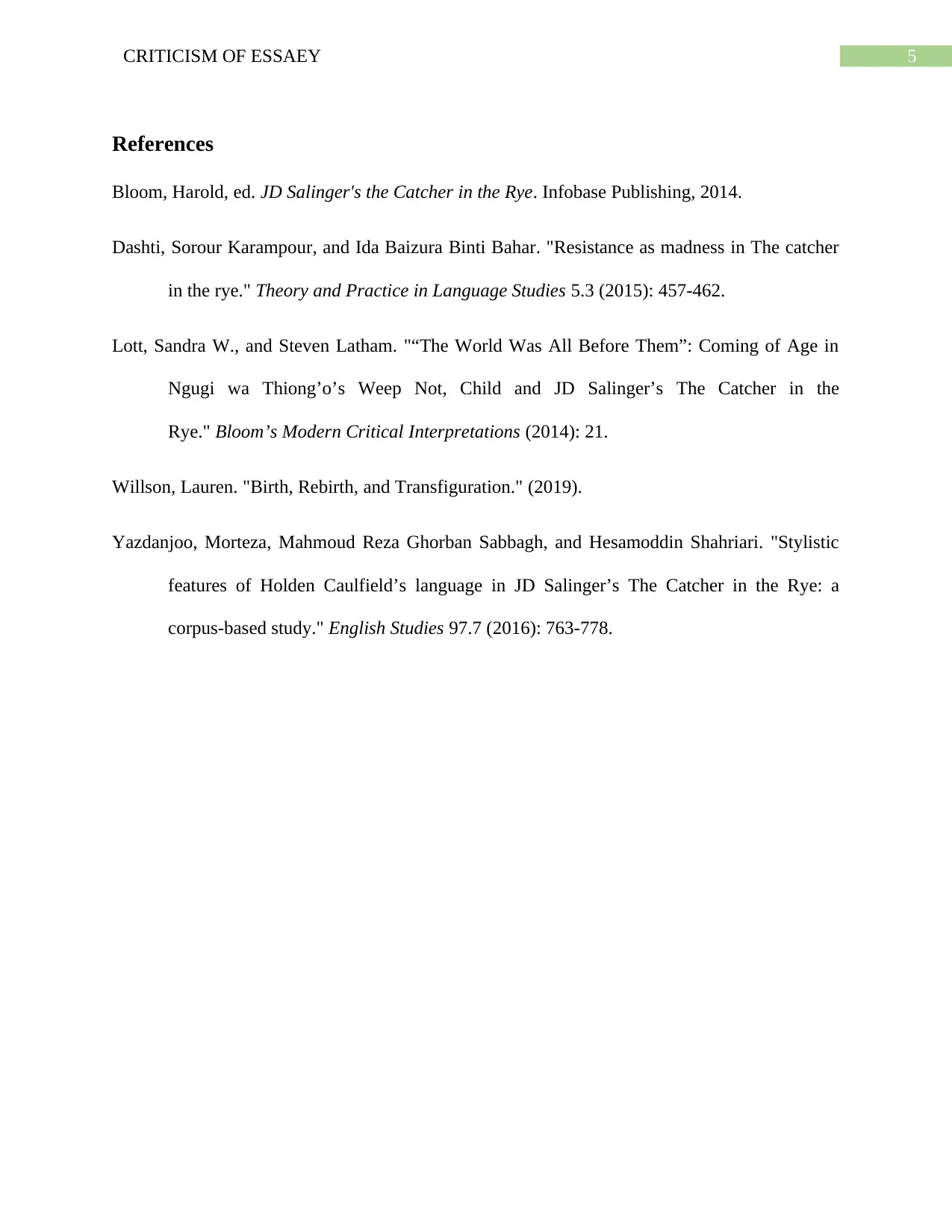
5CRITICISM OF ESSAEY
References
Bloom, Harold, ed. JD Salinger's the Catcher in the Rye. Infobase Publishing, 2014.
Dashti, Sorour Karampour, and Ida Baizura Binti Bahar. "Resistance as madness in The catcher
in the rye." Theory and Practice in Language Studies 5.3 (2015): 457-462.
Lott, Sandra W., and Steven Latham. "“The World Was All Before Them”: Coming of Age in
Ngugi wa Thiong’o’s Weep Not, Child and JD Salinger’s The Catcher in the
Rye." Bloom’s Modern Critical Interpretations (2014): 21.
Willson, Lauren. "Birth, Rebirth, and Transfiguration." (2019).
Yazdanjoo, Morteza, Mahmoud Reza Ghorban Sabbagh, and Hesamoddin Shahriari. "Stylistic
features of Holden Caulfield’s language in JD Salinger’s The Catcher in the Rye: a
corpus-based study." English Studies 97.7 (2016): 763-778.
References
Bloom, Harold, ed. JD Salinger's the Catcher in the Rye. Infobase Publishing, 2014.
Dashti, Sorour Karampour, and Ida Baizura Binti Bahar. "Resistance as madness in The catcher
in the rye." Theory and Practice in Language Studies 5.3 (2015): 457-462.
Lott, Sandra W., and Steven Latham. "“The World Was All Before Them”: Coming of Age in
Ngugi wa Thiong’o’s Weep Not, Child and JD Salinger’s The Catcher in the
Rye." Bloom’s Modern Critical Interpretations (2014): 21.
Willson, Lauren. "Birth, Rebirth, and Transfiguration." (2019).
Yazdanjoo, Morteza, Mahmoud Reza Ghorban Sabbagh, and Hesamoddin Shahriari. "Stylistic
features of Holden Caulfield’s language in JD Salinger’s The Catcher in the Rye: a
corpus-based study." English Studies 97.7 (2016): 763-778.
1 out of 6
Your All-in-One AI-Powered Toolkit for Academic Success.
+13062052269
info@desklib.com
Available 24*7 on WhatsApp / Email
![[object Object]](/_next/static/media/star-bottom.7253800d.svg)
Unlock your academic potential
© 2024 | Zucol Services PVT LTD | All rights reserved.